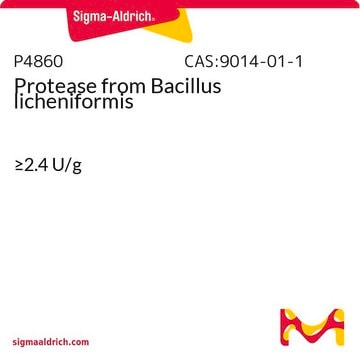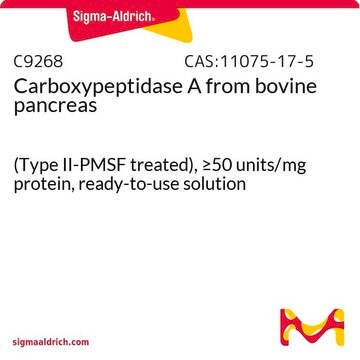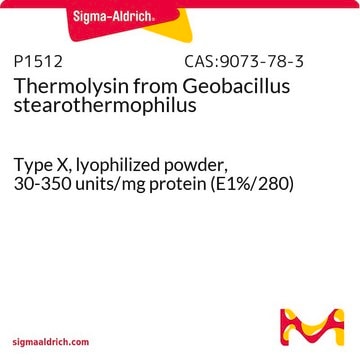T7705
Thimet Oligopeptidase from Bacillus licheniformis
Zaloguj sięWyświetlanie cen organizacyjnych i kontraktowych
About This Item
Polecane produkty
rekombinowane
expressed in E. coli
Poziom jakości
Postać
powder
masa cząsteczkowa
~77 kDa
temp. przechowywania
−20°C
Powiązane kategorie
Opis ogólny
Thimet oligopeptidase is considered essential in the degradation of collagen in collaboration with collagenolytic enzymes. Thimet oligopeptidase (TOP) is a neuropeptidase involved in the hydrolysis of gonadotropin-releasing hormone, a key component of the hypothalamic-pituitary-gonadal axis.
Zastosowanie
Thimet oligopeptidase can be used for the degradation of collagen in combination with collagenases. It can also be used for the hydrolysis of neuropeptides such as bradykin, neurotensin, and amyliod-β-peptide. Thimet oligopeptidase has been used in a study to investigate the effect of acute cocaine administration in male rats on TOP specific activity and mRNA levels in prosencephalic brain areas related with the reward circuitry: ventral striatum, hippocampus, and frontal cortex.
Uwaga dotycząca przygotowania
This enzyme has been affinity chromatographically purified using a niquel affinity column. It contains a 6-Histidine tag in its C-terminus.
A working solution of this enzyme can be prepared in 20 mM phosphate buffered saline solution, pH 7.0, or sterile and deionized water, pH 7.0.
A working solution of this enzyme can be prepared in 20 mM phosphate buffered saline solution, pH 7.0, or sterile and deionized water, pH 7.0.
This page may contain text that has been machine translated.
Hasło ostrzegawcze
Warning
Zwroty wskazujące rodzaj zagrożenia
Zwroty wskazujące środki ostrożności
Klasyfikacja zagrożeń
Acute Tox. 4 Inhalation - Skin Irrit. 2
Kod klasy składowania
11 - Combustible Solids
Klasa zagrożenia wodnego (WGK)
WGK 3
Temperatura zapłonu (°F)
Not applicable
Temperatura zapłonu (°C)
Not applicable
Certyfikaty analizy (CoA)
Poszukaj Certyfikaty analizy (CoA), wpisując numer partii/serii produktów. Numery serii i partii można znaleźć na etykiecie produktu po słowach „seria” lub „partia”.
Masz już ten produkt?
Dokumenty związane z niedawno zakupionymi produktami zostały zamieszczone w Bibliotece dokumentów.
Akio Kawasaki et al.
The Journal of biological chemistry, 285(45), 34972-34980 (2010-09-08)
Pz-peptidase A, from the thermophilic bacterium Geobacillus collagenovorans MO-1, hydrolyzes a synthetic peptide substrate, 4-phenylazobenzyloxycarbonyl-Pro-Leu-Gly-Pro-D-Arg (Pz-PLGPR), which contains a collagen-specific tripeptide sequence, -Gly-Pro-X-, but does not act on collagen proteins themselves. The mammalian enzyme, thimet oligopeptidase (TOP), which has comparable
Lilian C Russo et al.
Proteomics, 12(17), 2641-2655 (2012-06-29)
Protein interactions are crucial for most cellular process. Thus, rationally designed peptides that act as competitive assembly inhibitors of protein interactions by mimicking specific, determined structural elements have been extensively used in clinical and basic research. Recently, mammalian cells have
T John Wu et al.
Journal of neuroendocrinology, 21(4), 293-298 (2009-02-13)
Gonadotrophin-releasing hormone (GnRH) was first isolated in the mammal and shown to be the primary regulator of the reproductive system through its initiation of pituitary gonadotrophin release. Subsequent to its discovery, this form of GnRH has been shown to be
Fernanda M Cunha et al.
The Journal of biological chemistry, 283(36), 24448-24459 (2008-07-12)
Protein degradation by the ubiquitin proteasome system releases large amounts of oligopeptides within cells. To investigate possible functions for these intracellularly generated oligopeptides, we fused them to a cationic transactivator peptide sequence using reversible disulfide bonds, introduced them into cells
Kirsty Cleverly et al.
Reproduction (Cambridge, England), 139(2), 319-330 (2009-09-17)
LHRH (GNRH) was first isolated in the mammalian hypothalamus and shown to be the primary regulator of the reproductive neuroendocrine axis comprising of the hypothalamus, pituitary and gonads. LHRH acts centrally through its initiation of pituitary gonadotrophin release. Since its
Nasz zespół naukowców ma doświadczenie we wszystkich obszarach badań, w tym w naukach przyrodniczych, materiałoznawstwie, syntezie chemicznej, chromatografii, analityce i wielu innych dziedzinach.
Skontaktuj się z zespołem ds. pomocy technicznej









